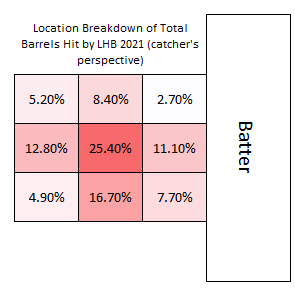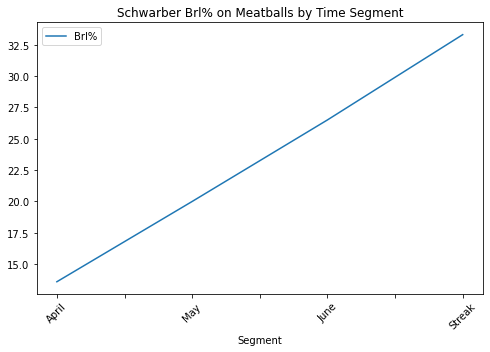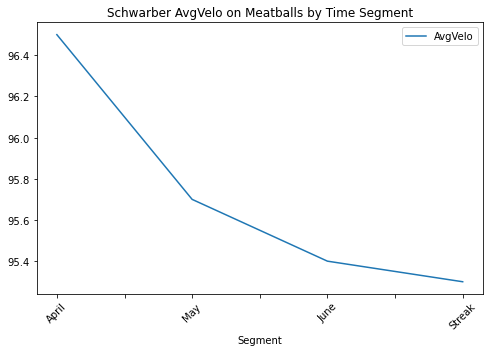It was the morning of June 13th, and Kyle Schwarber had played 53 games and seen 221 plate appearances with his new team, the Washington Nationals. He had signed with the team in the offseason after a long career with the Chicago Cubs where Schwarber had proved himself to be a more than useful Major League player and a great source of power.
Schwarber had pretty much given the Nationals what they expected from him up until that point, slashing .216/.308/.412 but racking up 10 home runs in that short time. There was definitely room for improvement as the .216 batting average and .308 on-base percentage were well below his career numbers in those categories.
That night, Schwarber hit two home runs against the Giants to bring his total to 12. It would turn out this performance was the start of one of the best stretches of hitting baseball had seen in recent memory.
Featured Promo: For this week only, take 50% off any full-season or yearly Premium Pass on the site! Just enter discount code THANKS when checking out. Thanks for being a reader, and Happy Holidays! Sign Up Now!
The Hot Streak Begins
Over his next 15 games, which encompassed 67 plate appearances, Schwarber would slash .373/.433/1.085 while hitting 14 home runs. That would tie him for the second-most June home runs in league history.
Baseball analysts and fans quickly took notice, and the proverbial cries of Schwarber being "hot" and "locked-in" rang out.
Over the last few decades, there has much dispute in the statistics community concerning the existence of the "hot hand." Very respectable intellectuals are on both sides of the matter. The debate took center stage in 1985 when a paper was published by Thomas Gilovich, Amos Tversky, and Robert Vallone that set out to disprove the notion of the "hot hand" in basketball. Watch a few basketball games on television and you are sure to hear an announcer describe a shooter as "hot." This theory suggests that a shooter can, for a short time, over-perform his average shooting percentage due to the mental and physical state he is in.
The paper provided a compelling case that what we deem as "hot" is actually just the result of randomness. That means it is nonsensical to expect a shooter to be more likely than average to make his next shot just because of the fact that he has made the last few. In fact, the paper found that shooters actually miss shots at higher rates after a streak of makes, most likely because over-confidence pulls them into taking more difficult shots.
Years later, another quite credible source of researchers at Stanford University claims to have debunked the 1985 paper, saying that the paper's findings were the result of an improper measuring system. If you want to try your hand at getting your mind around the math, the details are in the article.
So where does this leave us? Well I don't know where it leaves us, but I know where it leaves me - clueless.
In this piece, I am not seeking to contribute to the debate mentioned above. I am simply focused on the anecdote of Kyle Schwarber's recent performance. I want to dive into the numbers to see if I can provide any evidence for or against the theory that Schwarber is truly "hot" right now. Now, of course, Schwarber is "hot" in term of "he has performed really well recently" - that is undeniable. The [probably impossible] question to answer is whether or not this two-week stretch of homers is the result of randomness, or of truly elevated physical ability.
Below I will present questions I have asked myself along with the answers I derived from the Baseball Savant dataset.
Question #1: Is Schwarber Whiffing Less During His Streak?
We know Schwarber is hitting more home runs, and if that the reason for that is because he is truly "seeing the ball really well," we would expect him to also be making more contact. If you're seeing the ball and/or better able to control your fast-twitch muscles, a natural consequence would have to be a higher contact rate.
So let's check. I divided Schwarber's season into four segments. These segments are April, May, June, and then the time after June 13th when this streak of home runs began. I will use these segments a lot moving forward.
Here are two plots showing Schwarber's contact rate progression. For the year, his contact rate sits at 73%.


You can see in that first plot that Schwarber has still been susceptible to the whiff recently, with contact rates bouncing around from around 50% the whole way up to 100% recently, much in the same way that you saw in May as well. The second plot is certainly more telling, and you can see that his contact rate has, indeed, reached the highest level of the year during this hot streak.
This isn't super telling though, because this was going to be the case just due to the fact that we're looking at a guy who just swatted 14 homers in 67 plate appearances. It would be really unlikely to see any player's best streak of production not coincide with a higher than average contact rate - but nonetheless, it's true - he has been making more contact in the second half of June.
#2 Has He Been Seeing More Favorable Pitches?
As far as I'm concerned there are three possible explanations for a streak like this.
- Random chance
- The hitter is truly "locked-in" in the way that most people believe
- The hitter has seen many more hittable pitches recently
Number three is at least testable, so I tested it. 88% of home runs in 2021 have come from Barrels, which are batted balls that fit into the optimal angle/velocity combination. Because of this fact, I restricted the data to only barrels.
I looked at the strike zone to find where the majority of left-handed barrels come from. Here's the plot:

Middle-middle is the sweet spot, with the other non-corners of the zone also being exploited by lefties. Add those five zones together and you see that 74% of left-handed barrels have come from there. I was curious if Schwarber follows this mold as well, so I went back and broke this down using all of Schwarber's barrels since 2018:

Schwarber seems to prefer the ball lower rather than higher as 63% of his barrels have come from those four reddest zones above.
The next question is simple: has Schwarber seen more pitches in these zones since his hot streak began?

It turns out that yes, indeed, Schwarber has seen more pitches where he most likes them since June 13th, with 28% of the pitches he's faced being in one of those zones. Compare that to April and May and you see it's a significantly higher number (22% in April, 24% in May).
| Segment | Total Pitches | Total in Hot Zone | Hot Zone % |
| April | 269 | 59 | 22% |
| May | 472 | 113 | 24% |
| June | 438 | 119 | 27% |
| 6/13-6/28 | 275 | 78 | 28% |
Comparing June to May, Schwarber has seen six more pitches in these hot zones despite seeing 34 fewer total pitches.
Results on Favorable Pitches
Discovering that he's seen more pitches to drive during this hot streak doesn't prove anything (it turns out that nothing I am doing in this piece will actually prove anything, wink wink). He could still be "locked-in" and just really scorching the mistake pitches when they're made. Let's do some checks on that. I refer to the pitches in the hot zone as "meatballs" in the below plots, for reference.



His barrel rate on meatball pitches is way up lately, and that should have been expected given that we already know he's hit a ton of homers. What is interesting is that his whiff rate is actually higher on these pitches during the streak, and his average velocity is down as well. I'm not going to try to explain this, but it at least shows that he's not completely and totally "locked in" at the plate since he's actually making less contact at similar pitches during his hot streak as compare to the rest of his season.
Pitchers Faced
What about the individual pitchers Schwarber has faced? Here's the list of pitchers he's faced during the hot streak:
Tyler Anderson, Zach Thompson, Johnny Cueto, Joey Lucchesi, Cody Poteet, Sean Reid-Foley, Taijuan Walker, Jerad Eickhoff, Vince Velasquez, Jose Alvarado, David Peterson, JT Brubaker, Pablo Lopez, Sandy Alcantara, Chase De Jong, Sam Coonrod, Zach Pop, Zack Wheeler, Yimi Garcia, Seth Lugo, Ross Detwiler, Duane Underwood Jr., Miguel Castro, Aaron Loup, Bailey Falter, Anthony Bender, David Bednar, Jimmie Sherfy, Robert Gsellman, Richard Bleier, Archie Bradley, Clay Holmes, Jeurys Familia, Chasen Shreve, Yennsy Diaz, Ranger Suarez
I bolded the names I consider to be tough matchups, and you can see I only bolded seven of the 36 names in the list. That is an incredibly unscientific way to do this, so take that with a grain of salt, but it's useful to see the list.
To be a little more scientific about it, I took that list, along with the list of pitchers Schwarber faced in April and May, and found the season-long average barrel rate given up by all three lists. Here are the results:
| Segment | Average Barrel% |
| April | 7.4% |
| May | 7.9% |
| June | 7.2% |
| Hot Streak | 7.3% |
We are looking at a huge number of pitches in each segment there, so it's no surprise that all the results are concentrated right around the league average barrel rate, but it also appears to be true that Schwarber has not faced a bunch of pitchers with horrible barrel rates during this hot streak.
Where Does This Leave Us?
If you follow me on Twitter (@JonPGH), you have seen me this year been a proponent of "hot doesn't exist." I have done some DFS analysis myself on hot streaks, and my conclusion was that, overall, players are no more likely to beat their average DFS scores after three or five games of scoring a ton of points. That provided some evidence against the theory of a hitter being "locked-in" but it was far from authoritative and nowhere near the level of the intellectual studies I mentioned at the beginning of all of this.
If I had to guess, I think the truth comes from both sides. There is certainly randomness involved in hitting 14 homers in two weeks. It's probably also true that a streak like that is the result of a hitter being in great health and being more confident at the plate. Will we ever know for sure? Probably not, humans are weird, bro!
I am aware that I just wrote 1,800 words just to conclude with a shrug. So here's some actionable advice: if you have Kyle Schwarber right now, try to trade him to your league's biggest fish. There is probably somebody that actually believes that a 28-year old hitter that has been in the league for six years can suddenly elevate his game to a new level. Sure, that happens sometimes, but I don't think it's the case with Schwarber.
Chances are, from here on, he's more or less the guy he's been in the last there years, so if you can get a good haul for a player like that, it's a worthwhile venture.
Thanks for reading, I'm going to go play the lottery - I've been hot lately!
Download Our Free News & Alerts Mobile App
Like what you see? Download our updated fantasy baseball app for iPhone and Android with 24x7 player news, injury alerts, sleepers, prospects & more. All free!

More Fantasy Baseball Advice
 RADIO
RADIO





















